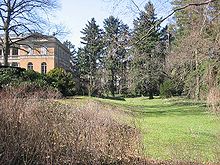Dianasee (Berlin)
| Dianasee | ||
|---|---|---|

|
||
| Dianasee | ||
| Geographical location | Berlin-Grunewald | |
| Data | ||
| Coordinates | 52 ° 29 ′ 11 ″ N , 13 ° 16 ′ 2 ″ E | |
|
|
||
| surface | 2 ha | |
| length | 350 m | |
| width | 60 m | |
| Maximum depth | 4.5 m | |
The Dianasee located in western Berlin district of Charlottenburg-Wilmersdorf on the outskirts of the villa colony Grunewald . It is named after Diana , the Roman goddess of the hunt, the moon and childbirth, also protector of women and girls.
The small, elongated lake with an area of around 25,000 m² is fed from the Grunewaldsee via a pipeline . It belongs to the glacial channel of the Grunewaldseenkette , which continues to the northeast with the Koenigssee , which is directly connected to the Dianasee. The Hundekehlesee follows to the southwest , but the Grunewaldrinne is previously interrupted by three built-up streets and is only noticeable again in a small, inconspicuous and nameless park, which is in front of the Dianasee south of Fontanestrasse and with its bent course indicates the narrow curve that the Grunewaldrinne here originally took.
Artificial lake from 1889

Like the three other lakes in the immediate vicinity, Koenigssee , Herthasee and Hubertussee , the Dianasee is not one of the original lakes of the Grunewald chain. Rather, there was a swampy, swampy depression in this former forest area as a connection from Hundekehlesee to Halensee , similar to today's nature reserves Langes Luch and Riemeisterfenn . In the 1880s, following personal intervention by Chancellor Otto von Bismarck , the Prussian state sold 234 hectares of the Grunewald forest to a bank consortium, which established the "Villa Colony Grunewald" after the area had been drained.
In the silted-up moors - the area of Lake Dianas was previously called “Diebsloch” - the builders, with the help of Polish workers, excavated the four lakes within a year in 1889; the water was filled using artesian wells . The villas were grouped picturesquely around the lakes, while the lakeshore and slope areas remained free of any development and became private gardens and parks for the entrepreneurs, bankers, professors and artists who came to the area in large numbers. Only since the 1980s have around 280 meters of the lake been accessible to the public from the parallel Koenigsallee and Fontanestrasse, which are to be expanded to 680 meters as part of the completion of the “Grunewalder Uferwanderweg”. Since the district is currently unable to purchase any land, the project, which is part of a landscape plan for the “small” Grunewald chain of lakes, is suspended .
Hasensprungbrücke
The bridges were built to match the splendor of the “Millionärsviertel”, for example the Hasensprung Bridge from 1920 , which is now a protected monument. The bridge spans the narrow connecting channel between Dianasee and Koenigssee on the “Hasensprung” pedestrian path. It was named after a wine-growing location west of Winkel in the Rheingau in Hesse . Allegedly this goes back to a wine- blissful evening of some colony founders, and various other names in the quarter go back to wine locations or grape varieties . The bridge with its rabbit sculptures offers a delightful view of the two lakes.
See in more detail
- to the riverside hiking trail and landscape plan: Koenigssee
- to the magnificent villas in the quarter: Hundekehlesee
Web links
- Neighborhood walk to lakes ... with Environment City Councilor Martina Schmiedhofer, July 12, 2003
- Local political walk ... with District Councilor Joachim Krüger, June 8, 2002



